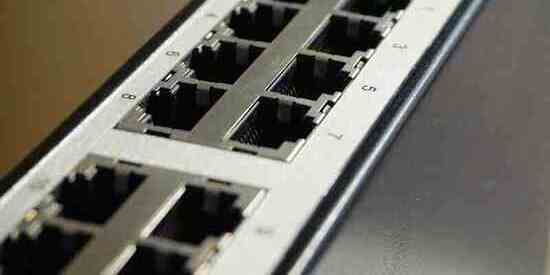When it comes to technology in our daily lives there are many purchasing decisions that come before the buy. Which streaming...
 When it comes to technology in our daily lives there are many purchasing decisions that come before the buy. Which streaming service will provide the best shows for the lowest price and result in fewer “what do we watch tonight” discussions? Is that Instant Pot really going to make dinner easier to make? Should I splurge on the new Nintendo Switch? The same is true for network switches. It's important to understand the fundamentals of network switches and what is a switch used for in networking.
When it comes to technology in our daily lives there are many purchasing decisions that come before the buy. Which streaming service will provide the best shows for the lowest price and result in fewer “what do we watch tonight” discussions? Is that Instant Pot really going to make dinner easier to make? Should I splurge on the new Nintendo Switch? The same is true for network switches. It's important to understand the fundamentals of network switches and what is a switch used for in networking.
WHAT IS A SWITCH IN A COMPUTER NETWORK?
A network switch establishes connections between devices within a network, facilitating communication through the exchange of data packets. Switches can be physical hardware devices that oversee physical networks or virtual devices based on software.
Switches don't just make your network faster; they also make it smarter. With advanced features like VLANs (Virtual Local Area Networks), you can segment your network into different virtual zones, enhancing security and optimizing performance. Plus, switches offer additional functionalities, such as Quality of Service (QoS), allowing you to prioritize certain types of data for an even smoother experience. And the best part? Using a switch is as easy as pie! No need to be a tech whiz or spend hours deciphering complicated manuals. Simply plug in your devices, power up the Switch, and let the magic unfold. Within minutes, you'll witness a network transformation that will leave you in awe.
Let us look at the basic functions of network switches and types of switches.
THE BASICS OF NETWORK SWITCHES
You know the importance of networking gear when keeping your organization running smoothly. It keeps your users connected to each other and the Internet, allowing for effortless transfers of data to designated devices.
However, if you’ve been tasked with the purchasing decision of a network switch, all the different models on the market can be overwhelming—especially when you want to choose the type of switch that will be the best fit for your organization.
Fortunately, our passion for networking equipment also translates to knowledge. Get ready to whip out your heroic alter ego and save your organization’s network system with our breakdown of types of switches, their benefits and how network switches work.
ETHERNET SWITCHES
We’ll start broad first—after all, every superhero should understand the big picture of his or her mission. Ethernet network switches, also known as LAN (local area network) switches, are an integral part of any computer network.
HOW DOES AN ETHERNET SWITCH WORK?
Picture this: a bustling office filled with employees relying on a single internet connection. With every click, every download, and every video conference, your network struggles to keep up. It's like rush hour on the information highway, and your data packets are stuck in an endless traffic jam.
Enter: Ethernet switches. Think of them as the brilliant traffic directors of your network. These ingenious devices act as intermediaries, efficiently managing the flow of data traffic to ensure a lightning-fast, uninterrupted connection for all your devices.
Imagine your Ethernet Switch as a master conductor, orchestrating a symphony of information. When you connect your devices to the switch, it instantly recognizes each one and assigns a unique path for data to travel. No more bottlenecks or frustrating lag!
But wait, there's more! Ethernet Switches don't just work their magic internally. They also empower you with incredible flexibility. Need to expand your network and connect more devices? No problemo! Ethernet Switches offer multiple ports, allowing you to effortlessly plug in additional computers, printers, or even your smart home devices. It's like giving your network the gift of superpowers! While an organization uses multiple network switches, types of ethernet switches can be broadly categorized into two main categories: Modular and Fixed switches.
MODULAR SWITCHES
If you’re looking for expansion capabilities, modular is where it’s at. Modular ethernet network switches make it possible for you to add expansion modules as needed into the switches. These types of switches provide the best flexibility, but come with a price because they are more complex than their fixed switch cousins. While you may have more limited flexibility, if you’re looking for a lower entry cost, fixed switches may be a better place to start.
FIXED SWITCHES
As their name implies, these switches typically aren’t expandable and they have a fixed number of ports. This category can be broken down even further into unmanaged, lightly managed, and fully managed. When it comes to network switches, the details matter.
Think of the Ninja Turtles’ Battle Shell—if Donatello hadn’t paid attention to what the turtles needed to upgrade their ride, they’d still be stuck with their sad Turtle Van. In the same way, you don’t want to end up with the wrong switch and delay taking your network to the next level.
UNMANAGED SWITCHES
These switches are most commonly used in home networks and small businesses. So, if you have a large organization this won’t be the option for you. These switches can’t be modified or managed, which is why it is important to assess the best unmanaged switch that would fit your organization’s requirements correctly.
They plug in and instantly start doing their job—hence the reason why they can be best for home users who don’t have the need or time for all the bells and whistles.
PARTIALLY MANAGED (SMART SWITCHES)
This is a category of ethernet network switches that change at the fastest pace. As with anything in the technology world, it doesn’t stay static for long. They straddle the middle ground because they offer basic management features with the ability to create some levels of security, but their management interface is more simplified than what managed switches offer.
They do offer the capability to set up options like Quality of Service (QoS) and VLANs. These can be helpful if your organization has VoIP phones, or if you want to segment your network into work groups. Bonus! These switches are also cheaper than their managed counterparts.
MANAGED SWITCHES
If you’re looking for the switch that has it all—the highest levels of security, precision control, and full management of your network—this is the switch for you. Think of it as the Avengers’ Quinjet, which can travel anywhere (outer space included), store useful tools for the team, and even includes an on-board medical bay.
Managed switches are the most costly option of them all, but if your organization has a large network it could be the best option for you. Since the scalability of these switches also makes them ideal for an emerging network, do ensure you assess the best managed switch for your organization’s requirements.
Now that we’ve understood more about what is a managed switch, let us look at the different kinds of considerations to be kept in mind for the best network switches.
ADDITIONAL CONSIDERATIONS FOR DIFFERENT TYPES OF NETWORK SWITCHES
Number of Ports
Switches can have anywhere from 5-port to 52-port configurations. When considering the number of ports you’ll need, you should think about the number of users your network supports. The larger your organization is, the more ports you’ll need. It is important to note that this will also entail learning more about the different types of ports and how they work.
Speed
Fixed configuration switches come in Fast Ethernet (10/100 Mbps), Gigabit Ethernet (10/100/1000 Mbps), Ten Gigabit (10/100/1000/10000 Mbps) and 40/100 Gbps speeds.
If all of this seems confusing, the biggest thing to consider when determining speed is the network needs of the users. Will they be transferring large volumes of data? Then Gigabit Ethernet or faster is likely the way to go.
PoE vs. non-PoE
Power over Ethernet (PoE) allows you to power a device like an IP phone or wireless access point over the same cable as your data traffic. If you have a larger network, PoE can provide you with great flexibility by allowing you to place endpoints anywhere in the office. This is especially handy in spaces where it’s difficult to run a power outlet.
Stackable vs. Standalone
Is your network growing rapidly? Then you may want to go with a stackable switch. Standalone switches need to be configured individually, and troubleshooting also needs to be handled on an individual basis.
Stackable switches allow for multiple switches to be configured as though they were one entity. One great advantage is that they can be configured. In the event of a port or cable failure, the stack of switches will automatically reroute around the failure.
We get it. The world of network switches can be complex. Now that you have a little more knowledge under your belt, we hope you can save the day by keeping your data secure and your network running efficiently.
Consider CXtec the Robin to your Batman.
Wondering what to do with old switches and networking equipment once you’ve completed your upgrade? Learn how you can sell your network hardware the smart way and maximize your return on investment with our Guide to Selling Your Network Hardware the Smart Way!
Recent Posts
When we discuss digital transformation, we...
Beyond the Upgrade Headache: Why Trading In Your...
Posts by Tag
- Server (12)
- Switches (11)
- Maintenance (10)
- IT Hardware (9)
- Refurbished (9)
- Dell Server (8)
- hardware (8)
- ITAD (7)
- Refurbished Servers (7)
- it assets (7)
- cisco (6)
- IT Infrastructure (5)
- network (5)
- Avaya (4)
- Hardware Failures (4)
- IT (4)
- IT Equipment (4)
- Sustainability (4)
- esg (4)
- microchip shortage (4)
- storage (4)
- supply chain (4)
- Dell Equipment (3)
- E-Waste (3)
- Avaya Phones (2)
- Cabling (2)
- HP (2)
- HP switch (2)
- IP Phones (2)
- IT costs (2)
- IT procurement (2)
- Server Maintenance (2)
- cisco router (2)
- data center (2)
- decommissioning (2)
- factory reset (2)
- lifecycle (2)
- lifecycle management (2)
- ucs (2)
- used cisco (2)
- used cisco hardware (2)
- ACP (1)
- AP (1)
- Access Points (1)
- Aruba (1)
- Avay 9620 (1)
- Avaya 1608 (1)
- Avaya 4600 Series (1)
- Avaya 9600 Series (1)
- Avaya 9608 (1)
- Avaya DHCP (1)
- Brocade (1)
- Carbon Offsetting (1)
- Data Security (1)
- Fiber Optic Cables (1)
- Fiber Optic Cabling (1)
- Hardware Security (1)
- Hybrid (1)
- IT Contributes (1)
- IT disposal (1)
- IT infrastructures (1)
- NETWORKING (1)
- POE (1)
- ProLiant Servers (1)
- R2v3 (1)
- SLAs (1)
- Safeguard (1)
- Switch (1)
- Used Network Equipment (1)
- data centers (1)
- data destruction (1)
- data disposal (1)
- environments (1)
- health (1)
- infrastructure (1)
- strategy (1)
- urban mining (1)
Popular Posts
In the cable world, the term structured cabling...
Switches are the “building blocks” of any modern...
Network switches are fundamental components of...








